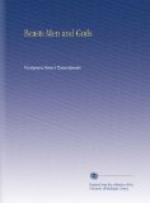In this wise the old Mongol, a simple, coarse shepherd and hunter, spoke to me.
Mongolia with her nude and terrible mountains, her limitless plains, covered with the widely strewn bones of the forefathers, gave birth to Mystery. Her people, frightened by the stormy passions of Nature or lulled by her deathlike peace, feel her mystery. Her “Red” and “Yellow Lamas” preserve and poetize her mystery. The Pontiffs of Lhasa and Urga know and possess her mystery.
On my journey into Central Asia I came to know for the first time about “the Mystery of Mysteries,” which I can call by no other name. At the outset I did not pay much attention to it and did not attach to it such importance as I afterwards realized belonged to it, when I had analyzed and connoted many sporadic, hazy and often controversial bits of evidence.
The old people on the shore of the River Amyl related to me an ancient legend to the effect that a certain Mongolian tribe in their escape from the demands of Jenghiz Khan hid themselves in a subterranean country. Afterwards a Soyot from near the Lake of Nogan Kul showed me the smoking gate that serves as the entrance to the “Kingdom of Agharti.” Through this gate a hunter formerly entered into the Kingdom and, after his return, began to relate what he had seen there. The Lamas cut out his tongue in order to prevent him from telling about the Mystery of Mysteries. When he arrived at old age, he came back to the entrance of this cave and disappeared into the subterranean kingdom, the memory of which had ornamented and lightened his nomad heart.
I received more realistic information about this from Hutuktu Jelyb Djamsrap in Narabanchi Kure. He told me the story of the semi-realistic arrival of the powerful King of the World from the subterranean kingdom, of his appearance, of his miracles and of his prophecies; and only then did I begin to understand that in that legend, hypnosis or mass vision, whichever it may be, is hidden not only mystery but a realistic and powerful force capable of influencing the course of the political life of Asia. From that moment I began making some investigations.
The favorite Gelong Lama of Prince Chultun Beyli and the Prince himself gave me an account of the subterranean kingdom.




